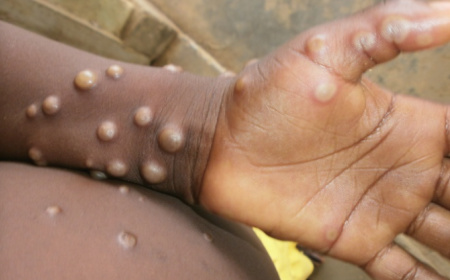Monkeypox
(Updated on 7 July 2022)
 Monkeypox is a rare disease caused by infection with the monkeypox virus, which is part of the same family of viruses as smallpox. The clinical presentation of monkeypox resembles that of smallpox, a related orthopoxvirus infection which was declared eradicated worldwide in 1980. Monkeypox is less contagious than smallpox and causes less severe illness.
Monkeypox is a rare disease caused by infection with the monkeypox virus, which is part of the same family of viruses as smallpox. The clinical presentation of monkeypox resembles that of smallpox, a related orthopoxvirus infection which was declared eradicated worldwide in 1980. Monkeypox is less contagious than smallpox and causes less severe illness.
Monkeypox is transmitted to humans through close contact with an infected person or animal, or with material contaminated with the virus. Monkeypox virus is transmitted from one person to another by close contact with lesions, body fluids, respiratory droplets, and contaminated materials such as bedding.
Monkeypox symptoms include fever, headache, muscle aches and backache, swollen lymph nodes, chills, exhaustion, a rash that can look like pimples or blisters on the face, inside the mouth, and on other parts of the body, like the hands, feet, chest, genitals, or anus. Monkeypox is rarely fatal.
Resources:
- UN Guidelines
Monkeypox Risk Mitigation Plan (English/French) (September 26, 2022)
Monkeypox Risk Mitigation Plan PowerPoint Presentation (September 2022)
- WHO
Public health advice for gatherings during the current monkeypox outbreak
Surveillance, case investigation and contact tracing for monkeypox: (interim guidance, 24 June 2022)
Vaccines and immunization for monkeypox (interim guidance, 14 June 2022)
Laboratory testing for the monkeypox virus (interim guidance, 23 May 2022)
Clinical management and infection prevention and control for monkeypox (interim rapid response guidance, 10 June 2022)
- Other Public Health Authorities
CDC Poster Monkeypox: Get the Facts Monkeypox: Get the Facts
CDC Print Handout: Social Gatherings, Safer Sex, and Monkeypox
